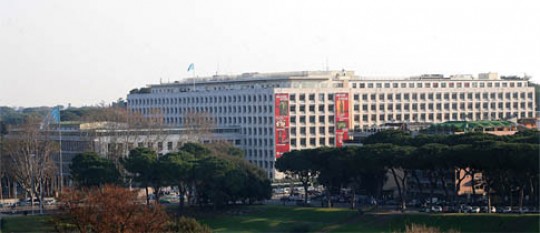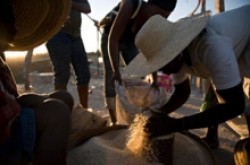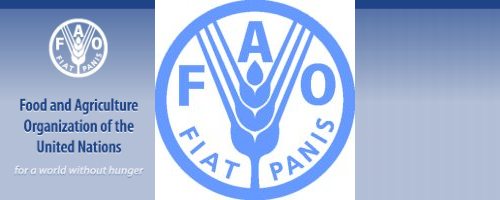Improved supply, global economic uncertainty cited
FAO Food Price Index down in October
Improved supply, global economic uncertainty cited
3 November 2011, Rome – The FAO Food price index dropped to an 11-month low in October, declining 4 percent, or nine points, to 216 points from September. Nonetheless prices still remain generally higher than last year and very volatile, FAO said.
Rice being sold at the Pontsonde market on the banks of the Artibonite River, Haiti./ Photo Fao/Walter Astrada
The drop was triggered by sharp declines in international prices of cereals, oils, sugar and dairy products. Meat prices declined the least. However FAO’s November Index published today showed that prices last month were still some 5 percent above the corresponding period last year.
An improved supply outlook for a number of commodities and uncertainty about global economic prospects is putting downward pressure on international prices, although to some extent this has been offset by strong underlying demand in emerging countries where economic growth remains robust.
Below recent highs
Most agricultural commodity prices could thus remain below their recent highs in the months ahead, according to FAO’s biannual Food Outlook report also published today. The publication reports on and analyzes developments in global food and feed markets.
In the case of cereals, where a record harvest is expected in 2011, the general picture points to prices staying relatively firm, although at reduced levels, well into 2012.
Food Outlook forecast 2011 cereal production at a record 2 325 million tonnes, 3.7 percent above the previous year. The overall increase comprises a 6.0 percent rise in wheat production, and increases of 2.6 percent for coarse grains and 3.4 percent for rice. Globally, annual cereal food consumption is expected to keep pace with population growth, remaining steady at about 153 kg per person.
Cereal Price Index
International cereal prices have declined in recent months, with the FAO Cereal Price Index registering an eleven month-low of 232 points in October. But nonetheless cereal prices, on average, remain 5 percent higher than last year’s already high level.
Severe problems caused by flooding recently marred rice production prospects in Thailand. However, impact on the international market has been limited so far given large reserves.
Large global supplies of sugar have put downward pressure on sugar prices since June. Improved supplies also weighed on dairy markets while strong palm oil output and record sunflower seed crops have driven prices down in the oils sector in recent months.
According to Food Outlook prices generally remain “extremely volatile,” moving in tandem with unstable financial and equity markets. “Fluctuations in exchange rates and uncertainties in energy markets are also contributing to sharp price swings in agricultural markets,” FAO Grains Analyst Abdolreza Abbassian noted.
Import bill
High food prices are putting pressure on Least Developed countries (LDCs) who have seen their food import bill soar by almost a third from last year, the report found. The global cost of national food imports is expected to approach $1.3 trillion this year.
World cereal inventories are forecast to increase by 3.3 percent from their reduced opening levels, to 507 million tonnes by the end of seasons in 2012. At this level, the world cereal stocks-to-use ratio for 2011/12 is expected to approach 22 percent, up only slightly from 2010/11.
AMIS System to improve information, transparency
The new issue of Food Outlook includes a chapter on the new Agricultural Market Information System (AMIS), established by the G20 earlier this year and housed at FAO Headquarters in Rome.
AMIS is managed by a joint Secretariat composed of nine international organizations (FAO, IFAD,OECD, UNCTAD, WFP, the World Bank, the WTO, IFPRI and the UN High Level Task Force the Global Food Security Crisis) with capacity to collect, analyse and disseminate information on a regular basis regarding the current and future food market situation and food policies.
In addition to the Secretariat, AMIS includes two groups, performing the following important functions: the Global Food Market Information Group to collect and analyse food market information and theRapid Response Forum to discuss policy responses.
###
> UN Food and Agriculture Organization (FAO).
The Food and Agriculture Organization of the United Nations (FAO) is an intergovernmental organization and has 191 Member Nations, two associate members and one member organization, the European Union. Achieving food security for all is at the heart of FAO’s efforts – to make sure people have regular access to enough high-quality food to lead active, healthy lives.

FAO’s mandate is to raise levels of nutrition, improve agricultural productivity, better the lives of rural populations and contribute to the growth of the world economy.
The Food and Agriculture Organization of the United Nations (FAO) is working with its Members and the entire international community for achievement of the Millennium Development Goals.
These eight goals – each with specific targets and indicators – are based on the United Nations Millennium Declaration, signed by world leaders in September 2000. They commit the international community to combating poverty, hunger, disease, illiteracy, environmental degradation, and discrimination against women.
![]()
The eight Millennium Development Goals are:
Goal 1: Eradicate extreme poverty and hunger
Goal 2: Achieve universal primary education
Goal 3: Promote gender equality and empower women
Goal 4: Reduce child mortality
Goal 5: Improve maternal health
Goal 6: Combat HIV/AIDS, malaria and other diseases
Goal 7: Ensure environmental sustainability
Goal 8: Develop a Global Partnership for Development
* More information at UN Food and Agriculture Organization (FAO)
###
> United Nations (UN).
 The United Nations was established on 24 October 1945 by 51 countries committed to preserving peace through international cooperation and collective security. Today, nearly every nation in the world belongs to the UN: membership totals 192 countries.
The United Nations was established on 24 October 1945 by 51 countries committed to preserving peace through international cooperation and collective security. Today, nearly every nation in the world belongs to the UN: membership totals 192 countries.
When States become Members of the United Nations, they agree to accept the obligations of the UN Charter, an international treaty that sets out basic principles of international relations. According to the Charter, the UN has four purposes:
- to maintain international peace and security;
- to develop friendly relations among nations;
- to cooperate in solving international problems and in promoting respect for human rights;
- and to be a centre for harmonizing the actions of nations.
###
* The above story is adapted from materials provided by United Nations (UN)
** More information at United Nations (UN)






















